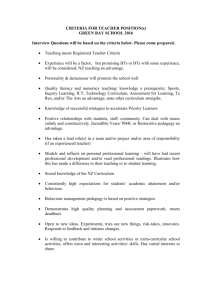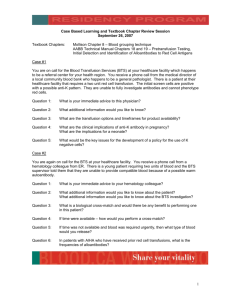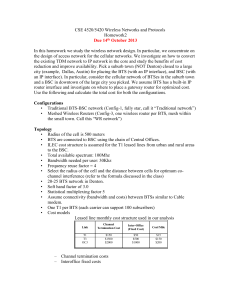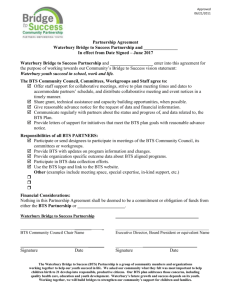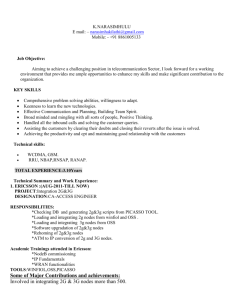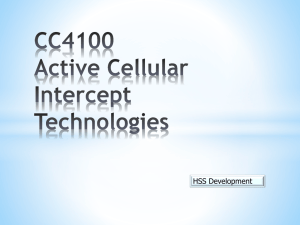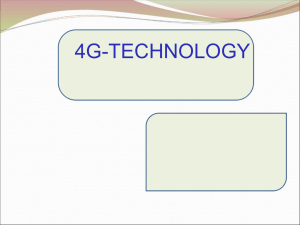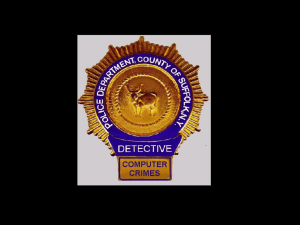Document
advertisement
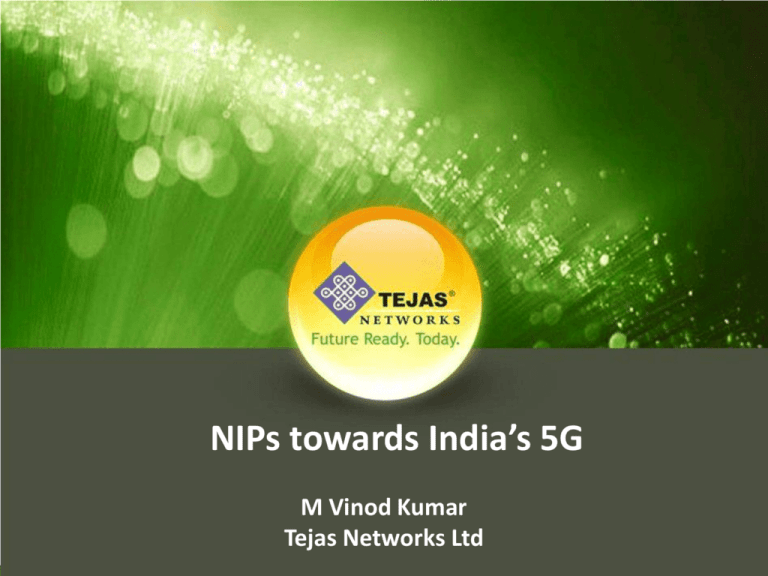
NIPs towards India’s 5G M Vinod Kumar Tejas Networks Ltd Thesis • India’s 5G requirement is different and therefore we need to ensure that: 1. We have complete method for X2 for HetNet BTS interoperation: Macro-Micro, Macro-Pico, MicroPico, BTS-RN 2. Relay Node is enhanced and used for reach, high capacity and non-line-of-sight backhaul 3. System Information is relooked, improved and also acquired quickly Agenda • • • • • • • What is G? India’s 5G requirement HetNet Relay Node X2 interface System Information Summary What is G? • G-Generation of TechnoloG – Not incremental – Support future services – but service agnostic • • • • • 1G-Analog 2G-Digital 3G-WCDMA 4G-OFDMA/SC-FDMA 5G- $5 p.m. in 5 years Sample Telecom Network Devices And Applications Devices And Applications Enable these devices to communicate at lowest cost and reliably with these devices. Devices Inside Home Metro “Ring roads’ Home Fiber or Copper Home Fiber Microwave or fiber Wireless Access Office Office Fiber or Copper LAN inside Office Devices Inside Home Cell Tower (2G/3G/LTE) Fiber Microwave or fiber Access Roads Fiber or Copper Fiber Cell Tower (2G/3G/LTE) Wireless Access National Highway System (“National Core”) Metro “Ring roads’ Optical Networks Access Equipment Fiber or Copper LAN inside Office Recap: Mobile Evolution Generation Name Data Rate / Speed 2G GSM 10kbps (voice) 2G CDMA 10kbps (voice) 2.5G GPRS ~50kbps 2.75G EDGE ~100kbps 3G WCDMA/UMTS 384kbps 3G CDMA 2000 384kbps 3.5G HSDPA/HSUPA 5-30Mbps 3.5G 1xEVDO rev A,B,C 5-30Mbps 4G LTE 100-200Mbps 4G WiMAX 100-200Mbps …Plus new enhancements to LTE 1000x 1000x Mobile: The Future of Internet Worldwide Access to Internet is growing and expected to touch 3 Billion in 2015 Mobile Broadband showed strong growth of 87% Y-o-Y in 2008-2012 in developing countries; 100% in Asia-pacific Evolution of Mobile Broadband FASTER ACCESS 1 GBPS 2010 4G 56 MBPS 2000 1990 1980 HEAVIER CONTENT Source: Sprint Traffic Analysis, 2013 3G 150 KBPS 2G 1G SUPERIOR PROCESSORS Source: Analysis Mason, 2014 LTE Deployment Worldwide Source: LTE Maps red marker per country for all operators to show commitments (trial, deploy, migrate, etc ) blue marker to show actual deployments. ©Tejas Networks Proprietary & Confidential 9 LTE: Broadband Wireless Access 350 LTE Base Station 300 250 200 Upload (MBPS) 150 Download (MBPS) 100 50 0 UMTS HSPA HSPA+ LTE LTE+ 4G/LTE promises “DSL-like” performance on a wireless link – high throughput and low latency (ideal for video) LTE-advanced promises peak rates of 1 Gbps on the downlink using new antenna technologies and modulation schemes By 2017, ~70% of global spend on wireless equipment will be on LTE • TD-LTE subscriber base in India to reach 67 million by 2017. India’s 5G • Scenario in India and other developing countries is different than developed countries • India already has dense Macro BTS deployment which we should capitalize on • ….So we have different 5G requirements Global Vs Indian Scenario Criteria Global Scenario Indian Scenario Affordability High Low BTS density Spectrum cost Fiber to villages High speed mobility Broadband penetration Spectrum availability Competition Sparse Medium No/Copper Yes High High Medium Dense High NOFN project No Poor Low Heavy 5G: METIS Objectives • To provide a system concept that supports – 1000 times higher mobile data volume per area – 10 times to 100 times higher number of connected devices – 10 times to 100 times higher typical user data rate – 10 times longer battery life for low power MMC – 5 times reduced End-to-End latency So Global Requirement is strictly not applicable for India Mobile Data Growth 12 10 APAC is almost 50% of Total 8 10x times 6 Total APAC 4 2 0 2012 2013 2014 2015 2016 2017 EXABYTE growth (66% CAGR) Source: Cisco VNI 2013 Demand Supply Analysis • Assumptions – 100 Mbps per sector, three sector per cell, LTE-Adv – 250 GB per month, peak rate 2.5 Mbps – Stat mux factor 10 • Mumbai City has 3,700 BTS and 5 mi households – Demand-Supply ratio = 1 • India has 7,40,000 BTS and 250 mi households – Demand-Supply ratio = 1 • Therefore with existing BTS density we can offer – 250 mi house holds * 250 GB => 10 Exabytes p.m. – 250 mi house holds * 2.5 Mbps => 1000 Exabytes p.m. Observation We can address the growth of traffic by: “1000 times over next 5 years” Target = 1000 Exabyte = 10 Power 21 Bytes “This is all India wants from 5G: 5 Year Plan” 1000x times Exabytes One Exabyte 5G Requirements • Primary means of broadband connectivity • DSL-like – Practically unlimited download – Always available/ON or low service delay • Low cost – Avoid roll out cost – Improve spectral efficiency with almost no new spectrum – Low power 5G Non- Requirements • Avoid massive BTS roll outs • Avoid new spectrum or more spectrum usage – Because cost is transferred to end-customer • No high speed solution • No multiple devices because it is primary connectivity • No ultra long reach radio solution – Village Panchayats have fiber- thanks to NOFN – Villages primarily need voice connectivity India wants from 5G: • 4G did not factor Indian scenario – It was designed for Elite – It cannot solve our problem • We want high spectral efficiency, low service latency at affordable cost • Primary broadband connectivity to 250 million households at Rs. 250 p.m. for 250 GB at peak rate of 2.5 Mbps (Stat mux 10x) Vision: $5/month “DSL-like” Mobile Broadband $100 Laptop $35 Tablet Primary broadband connectivity to 250 million households at the cost point of Rs. 250 p.m. for 250 GB at peak rate of 2.5 Mbps by 2017 Take Internet to Everyone! ~15 million fixed broadband connections which covers a mere 5% of the homes Huge demand potential in education and entertainment; over 250 million homes to be served in the coming years Bulk of data connections still on 2.5G Affordable Smartphones Launch 18 M 30 M 33 M 2011 2012 2013 2014 Affordable smartphones but 3G continues to languish in India; 4G yet to take off Can we better 4G? 3 Slow Growth in G Current 5G: More of the Same Sr. No. Technology Benefit Comments 1 LTE Advanced 10x throughput of LTE 5x bandwidth, large-scale MIMO 2 Full Duplex Doubles capacity On-going work 3 Higher frequency band Available, allows close packing of antennae Poor building penetration 4 Carrier Aggregation Increases bandwidth Throwing more bandwidth for higher rate 5 MIMO More layers, resiliency, reach/coverage Cannot use in low frequency bands; more expensive 6 HetNet or Cell Splitting Better frequency reuse Increases interference; addresses penetration problem 7 Spectral efficiency More data using the same bandwidth More focus is needed here as it enhances all of the above Case Study: Mobile Networks in India India has over 400,000 cell towers today 70%+ sites have grid outages in excess of 8 hours a day; 10% are completely offgrid Huge dependency on diesel generator sets for power backups Cell Tower, DG Set, Grid • India imports 3 billion liters of diesel annually to support these cell sites • CO2 emission exceeds 6 million metric tons a year • Energy accounts for ~25% of network opex for telcos As mobile services expand to remote rural areas, enormity of this problem grows Tejas Networks Proprietary 23 Energy Efficiency is a Major Challenge RAN is a major bottleneck Power Amplifier efficiency is abysmal Tejas Networks Proprietary Source: R. Ganti, IIT-M, IAFOE 2014 24 Key India-specific Requirements 5G must factor in the Indian requirement for DSL-like connectivity: Always ON, low latency, affordable cost To minimize cost, 5G must avoid using many more BTS sites, or much more spectrum, and focus on spectral efficiency 5G should allow virtual network operations enabling multiple operators to use the same physical network infrastructure India should grab the technology and standards leadership in 5G as China did in 4G 5G must work well in Indian propagation characteristics—dense, concrete buildings 5G infrastructure must be green—not just the CPEs or handsets— since we lack good grid connectivity Tejas Networks Proprietary 25 Relay Node enhancement LTE-Advanced Architecture • Show Rel-10 network with RN, Pico, MME, etc. MME_UE PDN_GW/internet Relay Node Pico Evolved Node B MME_RN Heterogeneous Network (HetNet) • Macro – high power and roof-top antennas, gains saturate as number increases due to ICI • Pico – for further increase in network capacity, but needs backhaul, has ICI at cell edge • Femto – for connectivity within a buildings, but needs DSL backhaul, has ICI at cell edge • Relay Node – for further increase in network capacity and coverage, it is non-line-of-sight, has no ICI, but needs coordination with Donor eNode B • There is no network element that is equivalent to Relay, however need to implement RN configuration messages Relay Node • India does not have high extensive DSL/Fiber connectivity • Our requirement is primary broadband and so latency/delay is not of any concern: Chain of Relay will solve problems – Such scenario can be optimized at multiple levels and we need to relook Relay again • Besides, for large Indian operators, unlike other BTS, Relay will not increase competition from small (future?) mobile operators – it will keep the current business intact • Therefore Relay based deployment is more promising Problem: The Loops • UE requests MME_UE • RN snoops the response and sends request to MME_RN MME_UE PDN_GW/internet Relay Node Pico Evolved Node B MME_RN Cell Phone Activity Cell Phone Activity Agile BTS • Notice that same region does not have activity all the time. • So strategic relay node and macro BTS may be needed for: – uncovering black-holed UE – beamforming in a coordinated manner depending on the activity • Interference can be drastically reduced if there are more Relays than small cell BTS X2 Definition Network MME / S-GW MME / S-GW S1 S1 S1 S1 X2 E-UTRAN eNB eNB X2 X2 eNB X2-AP • There are three ways to get Radio Resource messages – X2-AP – S1-AP – RIM • Out of this X2-AP is faster and required X2-Interface Use Case • CoMP • SON – Auto configuration – Optimization – Self healing • • • • ICIC Relay Node Network Cost SDN Coordinated MultiPoint • To improve cell edge throughput and improve overall average cell througput • Downlink – Joint processing: many transmitters to one UE either simultaneously or on time-share basis – Coordinated Scheduling/beamforming • Uplink – Joint reception – Coordinated Scheduling/beamforming Self Organizing Networks • Self-Configuring of X2 interface – Discover neighbour relation (ANR) • Self-optimizing – Mobility load balancing – Energy saving, e.g. by shutting down – Handover failure optimization • Self-healing Software Defined Network • Virtualization of eNodeB • One slice is one eNodeB or cell • Providing such a slice dynamically and on demand needs such eNode B to interact with other BTS over X2 Chain BTS without Backhaul • Sometimes BTS are chained over microwave backhaul • In such scenario S1-AP messages for handover from terminal BTS (small) to pen-ultimate BTS (macro) will lead to double the bandwidth consumption Relay Node • A Relay Node’s cell can experience interference with neighbouring eNode B, even if the donor eNode B does not experience such interference • This happens when RN is used for range extension of the donor cell • ICI can be reduced if RN coordinates with neighbour BTS over X2 Inter Cell Interference Coordination • Neighbouring eNodeBs coordinate their use of resources to help minimize intercell interference – Avoiding same resource blocks • This requires X2 signalling • Particularly important when there are going to be many small cells Deployment Cost • In HetNet, if small cells have to go to MME all the time for SON then Core Network will be overloaded by signaling messages and will deteriorate the network utilization • This will increase service latency given than two eNode Bs (small and macro) are 1-2 km compared to MME which is 100 km apart. X2 Definition • The 3GPP standard has provided guidelines for the X2 interface • We need to take these guidelines and define these APIs (all functions and variables) with more details so that they can be implemented as such for quicker network deployment by vendors and carriers/operators • Operators can enjoy an efficient network on day one! System Information System Information • System Information is read by UE in RRC Idle mode to acquire parameters necessary for – – – – – cell selection cell re-selection Paging SI change disaster notification, etc. • System Information (SI) in an LTE system is divided into a number of System Information Blocks (SIBs) and Master Information Block (MIB) System Information • The MIB includes limited number of most essential and frequently transmitted parameters to acquire other information from the cell • SI is defined in 3GPP TS 36.300 & 36.331 as a Radio Resource Control (RRC) message carrying a number of System Information Blocks (SIBs) that have the same periodicity • Each System Information Block (SIB) contains a set of related system information parameters • System Information Block Type1 (SIB1) is transmitted alone, separately from other SI-messages • SIBs other than SIB1 are carried in SI messages and mapping of System Information Blocks to SI messages is flexibly configurable by using scheduling Information parameters included in SIB1, with restrictions that each SIB is contained only in a single SI message. • Only SIBs having the same scheduling (periodicity) requirement can be mapped to the same SI message. Reading of System Information 1. Start with MIB – – BCCH BCH PBCH Downlink Channel Bandwidth, PHICH Config, SFN 2. Reading SIB1 after MIB – – BCCH DL-SCH PDSCH PLMN ID, TAC, cell selection parameters, Frequency Band, Cell barring, Scheduling of other SIBs 3. Reading other SIB after SIB1 – – – – BCCH DL-SCH PDSCH SIB2, SIB3, so on upto SIB19 Barring, RRC, Timers, MBSFN, etc. SIB2 has RRC message called Modification Period Coefficient Problem 1 • • • • • The number of SI bits that can be transmitted in any subframe is limited and the SI message should be transmitted in one subframe. This limits the number of System Information Block (SIB) messages that can be mapped to a single SI message. This decreases the number of SIB messages that can be mapped to a single SI message thereby delaying the acquisition of SI messages by UE, which as a consequence increases the power consumption of UE. There is another restriction in terms of ‘maximum bits that can be transmitted over a single subframe’. This restriction is due to channel condition, modulation and coding scheme, etc. This restriction requires that an SI message formed of multiple SIBs need to be segmented; but, there is no method defined for this segmentation. Therefore we need to provide flexibility in mapping SIB messages to a single SI message thereby providing opportunity for faster acquisition of SI messages by User Equipment (UE), which as a consequence reduces the UE power consumption. Problem 2 • • • • • Acquiring only modified system information is not possible. One needs to acquire all SI In the event that modification of system information is desired, the network can undergo a system information modification procedure by which all UEs communicating with the network are informed of an impending change to the system information. However, in conventional implementations, a wireless communication network conveys only a generalized indicator of an upcoming change of system information to its respective served UEs without providing any further information relating to the information to be changed. As a result, UEs communicating with the network can in some cases be required to re-acquire all system information at each modification regardless of the information to be affected by a given modification. Such a requirement can, in turn, degrade UE and/or network performance and power efficiency, an increase in UE implementation complexity, etc. Normally, during System Information Modification procedure, the eNB transmits the modified System Information in the corresponding modification period. The UE is informed through Paging Procedure and/or SIB2 about the SI modification. But the UE does not know which SI has got modified. The UE acquires the new system information immediately from the next SI modification period. This procedure is inefficient since the UE will acquire all SI messages irrespective of whether the SI message has got modified or not. There is a need to relook at acquiring modified system information messages in a user equipment. Problem 3 • Transmission conflict between SI and SIB1 for window length of 1 ms and thereby restricting the number of SI that can be transmitted in 1ms window • In LTE, for system information window length of 1 millisecond, the number of system information messages that can be transmitted is limited. It is specified in the LTE system that other SIs are not allowed to be transmitted in sub-frame #5 satisfying SFN % 2=0 in order to avoid mixing SIB1 and other SIs on the same sub-frame. Further uplink subframe and special subframe for which special subframe configuration does not support PDSCH transmission and MBSFN subframes block the transfer of system information message. • There is a need to overcome this problem so that transmitting conflict between the SI and SIB1 and the associated delay can be avoided. Example of 1ms Window SFN 0 SFN 1 SFN 0 SFN 1 Other problems • Transmission and decoding of multiple SI in a subframe • Transmitting longer SI i.e. SI with many SIB of same periodicity • SIB for ultra low rate IoT/M2M devices like water and electricity meters – Requirement from organizations like BESCOM and BWSSB Summary • NIP for India’s 5G – Relay enhancements – X2 definition development – SI message enhancements • Requesting Work Item on these NIPs for deeper study. Most study has already gone into these items at 3GPP. So requesting for both SI and WI so that RNES WG can have some WI to work for. Thank you. Questions? Extras… 4G: IMT-Advanced • Internet Protocol (IP) based network • Interoperate with existing wireless standards • A nominal data rate of 100 Mbit/s while the client physically moves at high speeds relative to the station, and 1 Gbit/s while client and station are in relatively fixed positions. • Scalable channel bandwidth 5–20 MHz • Peak link spectral efficiency of 15 bit/s/Hz in the downlink, and 6.75 bit/s/Hz in the uplink • System spectral efficiency of up to 3 bit/s/Hz/cell in the downlink and 2.25 bit/s/Hz/cell for indoor usage • Seamless connectivity and global roaming across multiple networks with smooth handovers • Others…. http://en.wikipedia.org/wiki/IMT_Advanced BTS Statistics in India Calculations Particulars Value Per cell rate (bps) 100,000,000 Sectors per cell 3 Peak data rate (bps) 2,500,000 Stat Mux 10 Cell rate to user rate 40 BTS in Mumbai 3,700 Households in Mumbai 5,000,000 BTS in India 740,000 Households in India 250,000,000 BTS in Mumbai can serve households 4,440,000 BTS in India can serve households 888,000,000 Supply is 1000 Exabytes • 5.75 x 10^20 is approximated to 1000 x 10^18 • 1000 x 10^18=1000 Exabytes = 1 Zetabytes Seconds per month 250 mi x 2.5 Mbps for 1 month 250 GB x 250 mi 100 Mbps x 3 sectors x 740000 BTS 740000 BTS x 100 Mbps x 3 sector x Stat mux 10 2592000 2.025E+20 6.25E+19 5.75424E+20 5.75424E+21
